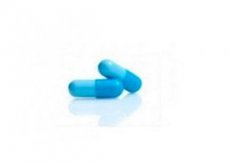Medical expert of the article
New publications
Preparations
Naproxen gel
Last reviewed: 03.07.2025

All iLive content is medically reviewed or fact checked to ensure as much factual accuracy as possible.
We have strict sourcing guidelines and only link to reputable media sites, academic research institutions and, whenever possible, medically peer reviewed studies. Note that the numbers in parentheses ([1], [2], etc.) are clickable links to these studies.
If you feel that any of our content is inaccurate, out-of-date, or otherwise questionable, please select it and press Ctrl + Enter.

Naproxen is an NSAID used for topical application.
Release form
It is produced in gel form, in 50 g tubes. One package contains 1 tube of gel.
 [ 3 ]
[ 3 ]
Pharmacodynamics
The gel has local analgesic, anti-inflammatory and anti-edematous properties. Naproxen, which is the active component of the drug, exhibits activity by suppressing the enzyme prostaglandin cyclooxygenase. COX provokes the process of oxidation of arachidonic acid with subsequent conversion to endoperoxides. Such a reaction is considered the initial phase of PG binding (they stop the late stage of the inflammatory process (edema and hyperemia)).
The anti-inflammatory effect of the active substance also manifests itself in the form of inhibition of lysosome activity, inhibition of leukocyte movement processes, and in addition in the form of neutralization of oxidants and inhibition of IL-2.
Since the gel contains ethanol with menthol, it has a superficial soothing and cooling effect on the skin.
Menthol, in addition to the cooling effect, causes local vasodilation, and also reduces the sensitivity of the nerve receptors of the skin. At the same time, it increases the absorption of the active substance through the skin.
Pharmacokinetics
After local application, the substance naproxen is absorbed more slowly than in the case of rectal or oral use. The peak indicator in the blood is noted 4 hours after applying the gel to the skin surface. After local use, there is a pronounced accumulation of the active component inside the skin, epidermis, and muscle tissue.
Application of the gel (10%) leads to a weak concentration of the substance inside the plasma (about 1.1%), and in the urine this indicator was 1%. At the same time, the indicators of locally applied Naproxen inside the synovial fluid were low (about 50% of its serum values).
About 99.9% of the substance is synthesized with plasma protein (the main part - with albumins). The drug is able to pass through the placenta and penetrate into breast milk. Concentrations of the substance in milk are approximately 1% of the serum drug levels.
Naproxen is excreted from the blood rapidly, with about 98% of the substance excreted in the urine. Of these, 10% are excreted unchanged, and 60% as synthesized naproxen (40% as glucuronides and another 20% as an unknown synthesized compound). In addition, 5% is excreted as 6-desmethyl naproxen, another 12% as 6-desmethyl naproxen glucuronate, and the remaining 11% are in the form of unknown synthesized compounds of 6-methyl naproxen. Approximately 0.5-2.5% of the substance is excreted in the feces.
Dosing and administration
The gel is applied externally - dry and clean skin should be treated (with a strip of gel about 4 cm long) 4-5 times a day, leaving intervals of several hours between procedures.
Then, after applying the drug, you need to distribute the gel and rub it into the skin until it is completely absorbed. After completing the procedure, you need to wash your hands to reduce the concentration of the substance absorbed through the skin. Do not stick a plaster or bandage to the treatment area.
The duration of the therapeutic course depends on the effectiveness of the drug, as well as the course of the pathology. In most cases, it lasts a maximum of 1 month.
If, after 7 days of using the gel, the swelling and pain do not decrease or, on the contrary, increase, you should consult your doctor.
 [ 15 ]
[ 15 ]
Use Naproxen gel during pregnancy
Animal testing of Naproxen has shown that it can delay labor. In addition, it damages the fetal cardiovascular system in humans (with possible closure of the arterial tract). For this reason, the drug is prohibited for use in pregnant women. The only exceptions are situations determined by the attending physician and under his supervision. Before using the gel, you need to make sure that the possible benefit to the woman in this case exceeds the risk of complications in the fetus (especially in the 1st and 3rd trimesters).
Since the active component of the drug is able to penetrate into breast milk, it is necessary to consider the option of stopping breastfeeding during the treatment period.
Side effects Naproxen gel
The use of the gel may cause the development of the following side effects: rashes (including vesicular), photosensitivity, irritation and burning sensation.
Long-term application of the drug to large areas of the skin can cause side effects due to the systemic properties of naproxen (including drowsiness, diarrhea and nausea, headaches and allergic reactions - erythema, itching with urticaria and skin rash).
Attention!
To simplify the perception of information, this instruction for use of the drug "Naproxen gel" translated and presented in a special form on the basis of the official instructions for medical use of the drug. Before use read the annotation that came directly to medicines.
Description provided for informational purposes and is not a guide to self-healing. The need for this drug, the purpose of the treatment regimen, methods and dose of the drug is determined solely by the attending physician. Self-medication is dangerous for your health.

